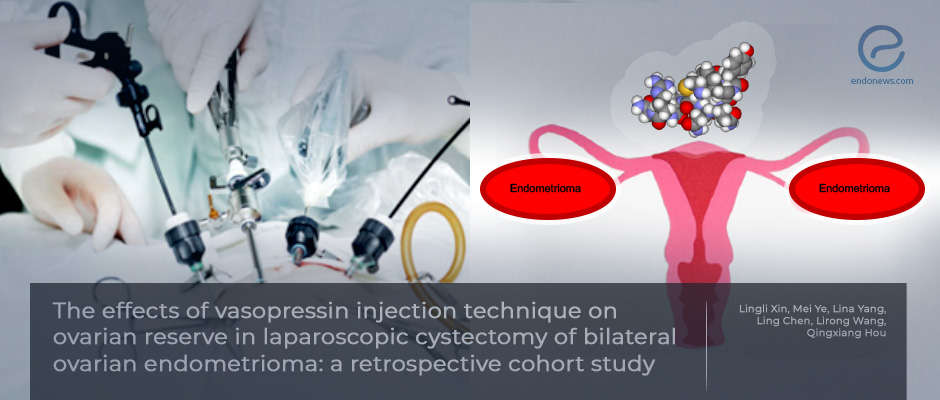How to reduce follicle loss during endometrioma surgery?
Aug 19, 2022
Vasopressin injection helps to protect ovarian follicles from burning effects.
Key Points
Highlights:
- Preservation of ovarian reserve may be possible by vasopressin injection through the cyst wall in patients with bilateral endometrioma.
Importance:
- To prevent the damage to ovarian follicles by excessive coagulation, the vasopressin injection technique significantly reduced the number of coagulation events and loss of ovarian tissues.
What's done here:
- The data of patients who had bilateral endometrioma excision between 2017 and 2020 were analyzed retrospectively.
- Patients who had regular menstrual periods have cysts larger than 5 cm, and who were not on any medical treatment were included.
- The groups were separated as vasopressin operations (VIT, n=61) and the rest as control (n=61), without vasopressin injection.
- The number of coagulation events by bipolar cautery after cyst removal, preoperative, and postoperative (1st, 3rd, and 6th month) AMH levels, the thickness of extracted ovarian tissue, and the follicle numbers excised with cyst wall were evaluated.
Key Results:
- The number of bipolar coagulations in the VIT group was significantly less compared to the control group.
- While AMH levels declined in both groups during the 1st-month, they were higher than in the control group in postoperative 1st, 3rd, and 6th months.
- The thickness of the cyst wall and the follicles lost with the cyst wall removal has been found to be significantly less when vasopressin is used.
Limitations:
- Prospective and long-term follow-up studies are required for further suggestions for vasopressin usage in routine daily practice.
Lay Summary
Bilateral endometrioma is a critical situation to decide on further approaches when both infertility and pain are concerned. Techniques to protect ovarian functions are crucial when applying a cyst removal is inevitable.
In the retrospective study conducted by Lingli Xin et al., the effects of vasopressin injection between cyst wall and ovarian tissue have been questioned in women with bilateral endometrioma.
122 patients who had regular menstrual periods have cysts larger than 5 cm, and who were not on any medical treatment have been included. The groups were separated as vasopressin operations (VIT, n=61) and the rest as control that no vasopressin injection has been applied. In the VIT group, diluted vasopressin has been injected through cyst walls. The number of coagulation events by bipolar cautery after cyst removal, preoperative, and postoperative (1st, 3rd, and 6th month) AMH levels, the thickness of extracted ovarian tissue, and the follicle numbers excised with cyst wall have been noted.
The number of bipolar coagulations in the VIT group was significantly less than in the control group. While AMH levels declined in both groups at the 1st-month check and recovered up to 60% of preoperative values, the levels in the VIT group were significantly higher than in the control group at every postoperative check-up. The thickness of the cyst wall and the follicles lost with the cyst wall removal were significantly less when vasopressin was used.
While the study has a retrospective manner with a lack of long-term follow-up results it gives a feasible explanation for the results that vasopressin protects the follicle pool with the help of the physical effect of the distracting cyst from the healthy ovarian cortex and by decreasing the coagulative events by causing vasoconstriction on surrounding vessels. This paper was recently published in the "American Journal of Translational Research".
Research Source: https://pubmed.ncbi.nlm.nih.gov/35559399/
bilateral endometrioma vasopressin AMH

